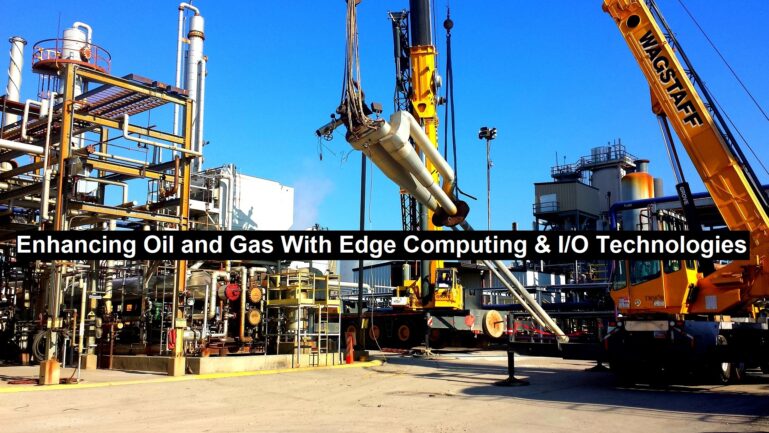Enhancing Oil and Gas With Edge Computing & I/O Technologies

Though it is easily one of the largest and most consequential sectors of the global economy, the oil and gas industry still has many challenges that stand between industry players and maximizing the efficiency and profitability of their companies. There are many different ways to address these problems, but first, let’s identify some of the main problem areas for oil and gas companies.
Highly competitive industry
Because it is a very lucrative industry, there is more competition for a large but limited market. Competition drives down the overall price of oil and gas products, reducing net profits over time. Because there are so many companies competing for the same customer base, analyzing and interpreting data about competitors is essential for companies wishing to gain market share in their region or expand into new regions.
Uncertain levels of future demand
There exists the conversation that a fossil fuel-powered society is on track to experience drastic and irreversible changes to Earth’s climate. As people become more and more aware of this dynamic, projections for future demand for oil and gas become less accurate. With solar and wind energy gaining popularity and electric cars becoming more accessible for middle-class folks, demand may be much lower in just a few short years.
Read: Maximizing Event ROI: Key Metrics Beyond Attendee Numbers
Extreme working conditions
Oil and gas deposits are often discovered in harsh, undeveloped areas with extreme temperatures. The scorching heat of the deserts of the Middle East and southwestern America and the unforgiving cold of the Arctic negatively impact the functionality of both machines and human workers.
Generation of massive amounts of data for analysis
The amount of data generated in the process of fossil fuel extraction is staggering—a single oil rig produces around one terabyte of data per day! That’s great because more detailed information allows for analysis, development of strategies for maximizing efficiency, and implementation of those strategies to reach an organization’s short- and long-term goals, but it’s an overwhelming amount of data to manage without the right infrastructure.
What Is Edge Computing?
Data is often stored either in a cloud, accessible from practically anywhere with an internet connection, or in a centralized data center. This can cause issues with latency, taking up energy and other resources—that could be better used for other purposes—simply to access information because of the distance between where the data is stored and the computer accessing the data.
Edge computing seeks to cut down on waste and increase efficiency by shifting data storage and management to a network of localized nodes. This allows the end-user to access data that is in their vicinity much more quickly. For example, when trying to solve real-time parking lot efficiency issues, one could employ an edge computing protocol, since the only relevant data is collected and utilized locally. Since most of the data generated in oil and gas extraction and production are relevant only to concerns in the immediate vicinity and, to a lesser extent, the region in which they operate, edge computing provides a faster, more direct mode of data sharing for the industry.
How Can Oil And Gas Companies Benefit From Edge Computing?
Oil and gas extraction and production produce a massive amount of data, but this data is usually only relevant to the facility that generates the data, meaning that storing it in a centralized location or in a cloud storage system would create a situation where accessing that information would take a very long time, use a lot of unnecessary energy, and generally be an inefficient method of data processing and analysis. A transition to edge computing would solve or reduce the impact of accessing and utilizing such large amounts of data. Remote monitoring can be used to quickly identify potential failures and give operators the time to address them before they become critical.
By organizing and storing data in a more localized way, edge computing makes it faster, easier, and more efficient to make use of the data generated by facilities like oil rigs. Saving time, money, energy, and manpower would be the direct result of the oil and gas industry shifting to an edge computing method of data management.
How could the oil and gas industry improve outcomes through the use of I/O technologies?
Input/output technologies, a cornerstone of computing, analysis, and data management, are devices that send information to or from computers in a network. Integrating I/O technologies with edge computing systems helps maintain smooth, hassle-free transmission of data from one computer to another. Wireless monitoring and control can be enhanced using programmable input and output actions for a completely customized and practical data communication process.
Managing And Using Data For Oil And Gas Facilities
Edge computing provides a new organizational schema for gathering, storing, and using locally-relevant data in the most efficient manner possible. In order to make the switch, there are some necessary investments into crucial hardware and software that a company must make before it can transition to operating under an edge computing model. For example, a purpose-built Oil and Gas SCADA System controls the exchange of information from within the locality in which it is operating to a centralized system or another smaller system. The ability to regulate data transfer over long and short distances alike makes it a lynchpin of a top-of-the-line edge computing system.
